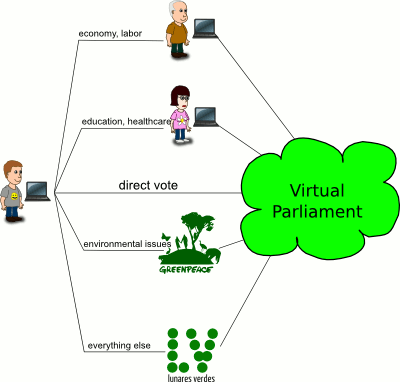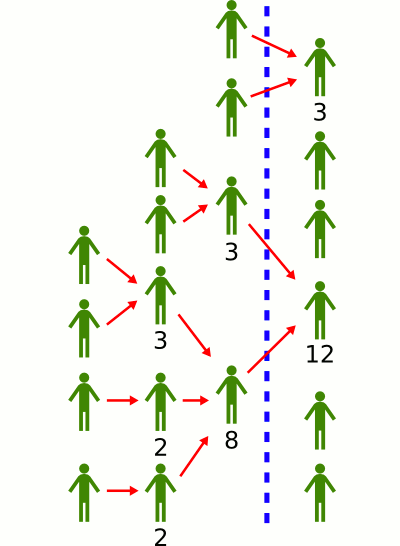Delegación de Voto

By using complex proxy vote, expert representatives can be chosen for each topic or group of topics
We have already discussed simple proxy vote, which means choosing an individual proxy to vote on a citizen’s behalf. However, digital proxy vote gives citizens many different options to manage their political power.
In an advanced Liquid Democracy system, different proxies could be chosen for each topic or group of topics (i.e. economic policies, environmental policies, educational policies...). In such a system, citizens would delegate their votes on experts whose views on each specialized topic they trust.
For example, a citizen’s proxy list could look like this:
Some decisions may involve different topics, so proxies could be assigned a priority number. So, going back to the sample list, the vote of the Economy proxy would be given priority in a decission involving Economy and Healthcare.
We could go further and name several proxies for each topic so that all of their votes would be taken into account for each decision.
In this case, a citizen’s proxy list could be:
This way, the votes of proxies 1, 2 and 4 would be taken into account for any decisions involving Economy and Labor.
We could go even further and design a system where each proxy’s competencies are assigned different values so that the votes of the different proxies are weighted before a decision is made.
For example, a citizen’s proxy list could look like this:
| priority | proxy | topic |
|---|---|---|
| 1 | Professor of Economics at UPNDDS | Economy, Labor |
| 2 | My sister Sonia | Education, Healthcare |
| 3 | Greenpeace | Environmental issues |
| 4 | The Green Dots Party | Everything else |
Some decisions may involve different topics, so proxies could be assigned a priority number. So, going back to the sample list, the vote of the Economy proxy would be given priority in a decission involving Economy and Healthcare.
We could go further and name several proxies for each topic so that all of their votes would be taken into account for each decision.
In this case, a citizen’s proxy list could be:
| proxy | topic | |
|---|---|---|
| 1 | Professor of Economics at UPNDDS | Economy, Labor |
| 2 | My sister Sonia | Education, Healthcare, Labor |
| 3 | Greenpeace | Environmental issues |
| 4 | The Green Dots Party | All topics |
This way, the votes of proxies 1, 2 and 4 would be taken into account for any decisions involving Economy and Labor.
We could go even further and design a system where each proxy’s competencies are assigned different values so that the votes of the different proxies are weighted before a decision is made.

Transitive proxy vote enables proxies to choose new proxies
Transitive proxy vote is a very interesting option which enables proxies to choose new proxies, thus creating “trust chains” to channel votes in an optimum fashion.
The “trust chains” would remain completely reconfigurable as citizens can choose new proxies at any time.
As citizens become increasingly satisfied with their proxy, the need to choose a new proxy decreases and vice versa. Therefore, more stable “trust chains” would indicate a high degree of citizen satisfaction while as unsatisfactory “trust chains” would naturally evolve to more satisfactory ones.
Here’s a brief explanation of the technical details
There are many options yet to be explored. Digital proxy voting is a powerful idea but it has never been realized. The aim of this website is to spread the message and gather the necessary support to turn it into reality.
NEXT >>
As citizens become increasingly satisfied with their proxy, the need to choose a new proxy decreases and vice versa. Therefore, more stable “trust chains” would indicate a high degree of citizen satisfaction while as unsatisfactory “trust chains” would naturally evolve to more satisfactory ones.
Here’s a brief explanation of the technical details
Transitive proxy vote creates a structure similar to an adaptive neuronal network in which synapses reconfigure to optimize output, that is, to maximize citizen satisfaction.
Obviously the system is highly complex and could become chaotic or unstable, going through ever changing configurations and never reaching a stable configuration. This could be a topic for academic research, in order to create the necessary conditions for stable evolution.
A logical way to regulate the system could involve limiting the number of proxy changes over time. Establishing a maximum number of proxy changes per year could be a stabilizing parameter.
There’s ample literature on this issue: Systems Theory, Neuronal Network Theory, and some research areas in Mathematics and Engineering deal with similar issues and could probably suggest ways to creating the right conditions for the stable evolution of a transitive proxy vote network.
Obviously the system is highly complex and could become chaotic or unstable, going through ever changing configurations and never reaching a stable configuration. This could be a topic for academic research, in order to create the necessary conditions for stable evolution.
A logical way to regulate the system could involve limiting the number of proxy changes over time. Establishing a maximum number of proxy changes per year could be a stabilizing parameter.
There’s ample literature on this issue: Systems Theory, Neuronal Network Theory, and some research areas in Mathematics and Engineering deal with similar issues and could probably suggest ways to creating the right conditions for the stable evolution of a transitive proxy vote network.
There are many options yet to be explored. Digital proxy voting is a powerful idea but it has never been realized. The aim of this website is to spread the message and gather the necessary support to turn it into reality.
NEXT >>

